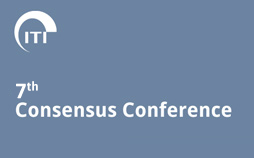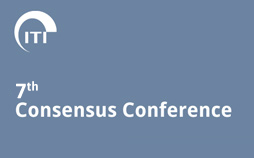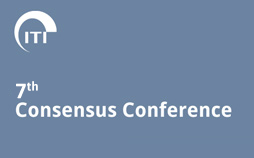
Clinical Performance of Immediately Placed and Immediately Loaded Single Implants in the Esthetic Zone
Consensus Statements
Consensus Statement 1: The Type 1A protocol, when utilized in the aesthetic zone, is a clinically viable treatment option. However surgical, technical and biological complications can occur. This statement is supported by 63 studies (10 randomized controlled trials, 28 prospective and 25 retrospective studies) with a follow-up ranging from 12 to 96 months. Surgical complications (mean per year 5.86%; 38 clinical studies) and technical (mean 3.27%; 25 clinical studies) and biological (mean 2.18%; 29 clinical studies) complications may occur.
Consensus Statement 2: For the Type 1A protocol, survival is not influenced by the type of implant (bone level vs. parallel walled vs. tapered design). This statement is supported by 63 studies (10 randomized controlled trials, 28 prospective and 25 retrospective studies) with a follow-up ranging from 12 to 96 months.
Consensus Statement 3: For the Type 1A protocol, there was an increase in PES when the space between the implant and the facial bone of the residual socket was grafted with autogenous bone or bone substitute. This statement is supported by 35 studies (7 randomized controlled trials, 12 prospective and 16 retrospective studies) with follow-up ranging from 12 to 96 months.
Consensus Statement 4: For the Type 1A protocol, the flapless approach provides good aesthetic outcomes (papilla height, PES and WES). This statement is supported by 11 clinical studies for papilla height, 31 clinical studies for PES and 16 clinical studies for WES.
Consensus Statement 5: For the Type 1A protocol, differences in survival are not influenced by type of retention (screw or cement retained) when focusing on the final restoration. This statement is supported by 29 clinical studies.
Clinical Recommendations
1) What clinical experience is recommended for the Type 1A protocol?
The Type 1A protocol is classified as a complex procedure (ITI SAC Classification, 2nd Edition, 2021) and should be performed by clinicians experienced in surgical and restorative implant procedures. These clinicians should have skills specific to tooth extraction and immediate implant placement, hard and soft tissue augmentation procedures and immediate loading/restoration of implants. A team approach is often needed.
2) How should a patient be clinically assessed for the Type 1A protocol?
A thorough clinical examination should be performed for the proper assessment of the patient and site. The patient should be assessed with the Esthetic Risk Assessment (ITI TG 10, SAC 2nd Edition) and risk assessment for immediate implant placement in single tooth sites (Hamilton et al. 2023, ITI TG 14) to determine the patient and site-specific risk factors for immediate implant placement.
3) What radiographs are recommended to properly assess a site for the Type 1A protocol?
Radiographic assessment of the site and relevant surrounding tissues with a good-quality periapical radiograph and a conebeam computed tomography (CBCT) scan is strongly recommended. The following radiographic criteria should be fulfilled:
- An intact or minimally damaged facial bone plate
- Sufficient bone available to provide primary stability in an ideal 3D position
- Health of the adjacent teeth
4) Is software planning recommended for the Type 1A protocol?
When a CBCT (digital volume) has been captured, the use of implant planning software is strongly recommended in order to evaluate the site and simulate the ideal 3D implant position. This allows the following to be analysed:
- The tooth–alveolus axis relationship allows planning for optimal 3D restoration-driven implant placement.
- The gap between the implant and the facial bone wall is at the level of the planned implant shoulder position.
- Abutment options.
5) What restorative preparation should there be prior to commencing treatment?
The prior fabrication and use of a traditional or computerguided surgical template is highly recommended to achieve an optimal restoratively driven 3D implant position. A provisional crown, shell crown or matrix should be prepared prior to tooth extraction according to the desired method for fabrication of the planned immediate implant restoration. An alternative provisional prosthetic replacement of the tooth should be prepared and available in the event the treatment cannot be completed due to intra-operative events.
6) How should the tooth be extracted when utilizing the Type 1A protocol?
A minimally traumatic tooth extraction with a flapless approach is recommended and all efforts should be made to preserve bone and soft tissue integrity. Special instrumentation may be required to achieve this goal. Debridement of the socket should be performed. The integrity of the socket walls should be confirmed following extraction.
7) What should be done if the facial bone is compromised when the tooth is extracted?
If the facial bone is compromised during and following tooth extraction, the extent of the defect must be assessed. If a minor defect in the facial bone is present, the Type 1A protocol may still be considered. However, the risk of aesthetic complications is increased and additional adjunctive hard and soft tissue regenerative procedures may be required. In larger defects, alternative treatment protocols to Type 1A must be considered.
8) Can the Type 1A protocol be done in the presence of chronic periapical infection?
The Type 1A protocol can be selected for teeth presenting with chronic periapical infections. However, it is recommended that this is only considered when the following conditions exist:
- Absence of a fistula
- Infection can be completely debrided
- There is sufficient bone remaining to provide primary implant stability
9) How big should the facial gap be?
The facial gap should ideally be >2 mm in width at the level of the implant shoulder. However, this may not always be possible and ultimately needs to be considered in relation to the likely functional loading, implant diameter and the dimensions of the socket.
10) What should be done when the facial bone or soft tissues are thin?
The following treatment can be considered:
- In thin-tissue phenotype situations, or when facial bone is thin (less than 1 mm), the Type 1A protocol can still be considered. However, in addition to grafting of the gap, adjunctive soft tissue grafting may be required to compensate for anticipated post-extraction dimension changes. This will increase the complexity of the procedure and the risk of adverse outcomes.
- Alternative implant placement and loading protocols may also be considered to reduce the risk.
11) What steps should be taken for connection of the provisional crown to the implant?
Immediate placement of a provisional restoration is well documented. This can be performed according to previously published consensus statements. The following factors should be considered:
- Screw retention is recommended.
- Emergence profile should be appropriate (not over- or under-contoured).
- Timeframe should be from implant placement to 1-week post placement.
- A highly polished surface of the provisional is required.
- The occlusion scheme should be without any eccentric contacts.
- Light proximal contacts should be present.
- The provisional restoration should be inserted and the retaining screw (abutment or prosthetic) torqued according to guidelines published by each manufacturer.
12) What should be done if the Type 1A protocol cannot be completed at the time of surgery?
If the Type 1A protocol cannot be completed, the implant can be placed with simultaneous grafting and allowed to heal without loading the implant. If the implant cannot be placed, an early placement protocol can be considered. Alternatively, the socket may be grafted and followed by late implant placement.
Patient Perspectives
1) Can you remove the tooth and place a dental implant and crown at the same time?
We need to perform an examination of your mouth and make an assessment of important clinical aspects. We will need to take X-rays, which will most likely include a 3D scan known as a CBCT. If conditions are favourable, we can consider removing the tooth, placing the implant and a crown at the same time. This response is based on scientific evidence.
2) What could go wrong during the procedure?
Every effort is made to avoid complications and risks. Even so, unforeseen problems can arise during the procedure. Complications that occur during the procedure will most likely be related to one or more of the following three things:
- Complications resulting from the extraction (removal) of the tooth MORTON et al. | 355
- Inability to properly place a stable dental implant or place the implant in the ideal restoratively driven 3D position
- Inability to place a restoration (crown) on the dental implant at the same appointment, requiring an alternative option to be considered
This response is based on scientific evidence and expert opinion.
3) What could go wrong after the procedure?
Minor postoperative discomfort and swelling are expected and can usually be managed with over-the-counter medications. Postoperative complications are relatively rare but possible. Most postoperative complications can be related to one or more of the following four things:
- Postoperative pain and/or bleeding
- Postoperative infection
- Postoperative loosening and/or failure (loss) of the implant
- Undesirable aesthetic outcomes
This response is based on scientific evidence and expert opinion.
Downloads and References
Related items
Share this page
Download the QR code with a link to this page and use it in your presentations or share it on social media.
Download QR code
